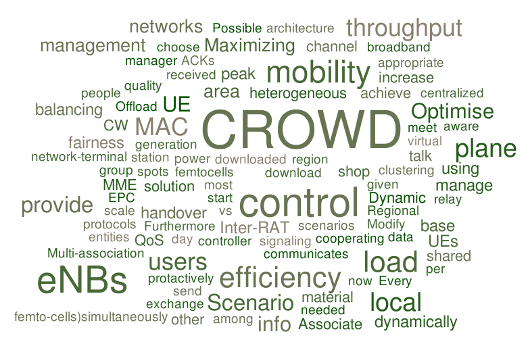IMDEA Networks

CROWD sets the pillars of 5G communications
24 February 2016

Researchers from IMDEA Networks Institute have successfully completed the CROWD* research project in the strategic domain of future communication and ICT services infrastructures. The European Commission has evaluated the project as significant beyond expectation, striking a very good balance between theoretical analysis and implementation.
After 3 years of enthusiastic research, system design and prototyping, the CROWD project has demonstrated to the European Commission (EC) new key concepts on network-controlled MAC and mobility management and dynamic backhaul reconfiguration. These key concepts range from opportunistic and cooperative use of device-to-device communication techniques to novel paradigms for the dynamic management of data flows of mobile users. The results of CROWD promise to make possible an Internet of mobile users cooperating with each other to deliver larger bandwidths and faster services. At the same time, cooperation between users is maintained under the control of the network operator, so that reliability and security are guaranteed jointly with greatly enhanced network performance.
The CROWD project has been technically managed by researchers from IMDEA Networks Institute, led by Dr. Vincenzo Mancuso, Research Associate Professor at the Institute, and coordinated by INTECS S.p.A., Italy.
The progress of the project has been considered by the EC as significant beyond expectation, striking a very good balance between theoretical analysis and implementation. Indeed, the researchers working on CROWD have defined and designed several innovative concepts, especially in the field of cooperative communications, opportunistic device-to-device techniques, and distributed mobile management schemes. The IMDEA Networks Institute and the University Carlos III of Madrid have lead both study and system design of such innovative mechanisms.
Setting the pillars of future 5G systems
The EC reviewers remarked that “the consortium has made very good progress during the review period and has achieved the overall project objectives to an excellent level”. The goal of the CROWD project is to design sustainable networking and software solutions for the deployment of very dense, heterogeneous wireless networks. Sustainability is targeted in terms of cost effectiveness and energy efficiency. Very high density means 1000x higher than current density (users per square meter). Heterogeneity involves multiple dimensions, from coverage radius to technologies (4G/LTE vs. Wi-Fi), to deployments (planned versus unplanned distribution of radio base stations and hot spots). The results of CROWD have been deemed key to set the pillars of future 5G systems, which are currently under design in the frame of numerous projects funded by the EC in the ICT Program H2020.

CROWD is a European funded project spanning from January 2013 to September 2015 under the technical supervision of IMDEA Networks Institute in collaboration with University Carlos III of Madrid, University of Paderborn (Germany), National Instrument, Alcatel Lucent France, the Turkish telecom operator AVEA, and the Italian provider of electronics INTECS.
Early results from the project have been published in top conferences and journals like IEEE INFOCOM and IEEE/ACM Transactions on Networking. The project has received an “Excellent” mark at the first year evaluation carried out by the European Commission Directorate General for Communications Networks, Content & Technology (DG CONNECT). Last, but not least, the project was selected by the European Commission (EC) to join the group of “early 5G precursor projects”. As such, it will contribute to the early showcasing of potential technologies for the future ubiquitous, ultra-high bandwidth “5G” infrastructure.
As the EC evaluation of the CROWD project has fully demonstrated, IMDEA Networks is one of the main leaders at European level in the field of 5G networks. Other 5G research projects carried out by the Madrid Institute are the ongoing SEARCHLIGHT, TIGRE-CM and CLOUD4BIGDATA, and the recently concluded iJOIN.
* Connectivity management for eneRgy Optimised Wireless Dense networks
Referencias bibliográficas:
Christian Vitale, Gianluca Rizzo, Vincenzo Mancuso (June 2015)
Dynamic Network Reconfiguration in Wireless DenseNets with the CROWD SDN Architecture (Paper) [PDF ]
The 24th European Conference on Networks and Communications (EuCNC 2015), 29 de junio – 2 de julio de 2015, Paris, Francia


Recent Comments